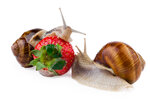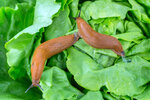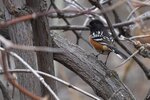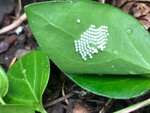




This week we are combining two columns to address how gardeners might deal with slugs and snails, and how their choices affect our avian neighbors.
How discouraging to come out to one’s garden in the morning only to find many holes chewed in the lettuce leaves and a trail of slime. Or, waiting until those strawberries are just right for picking and find holes chewed in all the best ones and yet another trail of slime.
Slugs from Europe, common pest in NW Gardens.
The culprits, of course, are slugs and snails. These creatures are the bane of Northwest gardeners in large part because our generally damp climate creates excellent breeding conditions for them and they respond accordingly. Also, these favorable conditions have allowed European slugs, likely brought here accidentally, to thrive. Those large and common black and brown slugs are originally from Europe and now constitute a major agricultural pest.
Banana Slug - Not a Garden Problem - eats only dead materials.
George likes snails and slugs because they provide food for birds. Jill wishes birds actually ate more of them, leaving fewer to dine on the lettuce in her garden. This jointly written column is an attempt to satisfy both goals: more dead slugs, and more living, hungry birds.
Slugs and snails are mollusks, related to some shellfish. Both of us care less about their family trees and personal habits than their role in bird life and gardens. (However, Jill was fascinated by the tidy pattern of their eggs on the underside of a leaf; she was surprised that a slug would be so orderly. See photo, above.)
Birds mostly eat the small slugs and snails; when you see a Spotted Towhee (which looks like a dressed-up robin) scratching the ground searching for food, young slugs, snails and eggs are on its menu.
The grim reason we are writing about these hapless creatures is to offer information about how to kill them without also killing birds or anything else.
The poison in most common slug-killers used to be metaldehyde, which was also poisonous to the birds, dogs, cats and other critters who eat young slugs and snails. The most common brand of slug bait, Sluggo, no longer contains it. Neither do most other brands. But the hardcore Deadline still does. Its motto: “You will see dead slugs.” Apparently, the slugs die so fast that they remain in plain sight rather than crawling under a leaf. They argue that birds and other critters won’t eat them because they turn an ugly color – we’re skeptical.
Most slug and snail baits now in use – including Sluggo – rely on iron phosphate, giving its victims a fatal dose of indigestion, but it is nontoxic to others. It works more slowly, and the slugs and snails crawl off to die hidden from sight.
Still, as long as we’re wallowing in grim today, one should note that there are many ways to kill slugs. Jill’s favorite was an alcoholic beverage called Mickey’s Big Mouth. A not quite empty bottle of it, laid on its side in the garden in the evening, would have several dead slugs in it by morning. A more formal version of the same idea was to leave a saucer of beer in the garden where slugs and snails could easily crawl in. In both cases, we liked to think the slugs died happy, but that, I am sure, was self-deceit.
George preferred the ritual of strolling through the garden at dusk with a saltshaker in hand, and seasoning the slugs to death.
George’s first draft of this column supported the idea of using copper strips as effective slug deterrents, but Jill counters with research from the Royal Horticultural Society, reported in The Guardian, that says copper doesn’t work.
However, the same article also reported skepticism about Jill’s favorite remedy: “One famous method not yet tested is beer traps.” Dr. Hayley Jones, an entomologist, said she “would like to test this method because there is a risk such traps only lure more slugs onto gardeners’ vegetable patches.”
We both suspect that this entomologist may have a pro-beer bias. And Jill’s sister, here on a visit, wonders why anyone would waste beer on slugs.
Bottom line: If you want to, or need to, fight against a slug or snail infestation in your garden, we urge you to employ a method that does not use metaldehyde because, in our view, the risk of unintended deaths is too great.
Jill Severn writes from her home in Olympia, where she grows vegetables, flowers, and a small flock of chickens. She loves conversation among gardeners. Start one by emailing her at jill@theJOLTnews.com
George Walter is environmental program manager at the Nisqually Indian Tribe’s natural resources department; he also has a 40+ year interest in bird watching. He may be reached at george@theJOLTnews.com
Photos for George Walter's columns are provided by Liam Hutcheson, a 15-year-old Olympia area birder and avid photographer.
4 comments on this item Please log in to comment by clicking here
psterry
Thank you both for alerting birders and gardeners about the hazards that some slug baits pose.
People will kill slugs, and most people have no idea that slug bait harms birds (and other pets).
Beer is OK, but I've had slugs crawl right out of a pie plate after drinking their fill. Also, it has to be fresh beer, or they're not interested. I'll have to try Jill's solution if it is cheaper than beer.
Deadline is by far the most effective slug bait. It used to come in a gray gel form, but now comes only in pellet form, which is deadlier to birds because they are attracted to the grain in the pellets. I am trying bait under pot saucers propped up by a twig just big enough to let in a slug but too small for a bird. Here's the issue though: if Sluggo or Corrys, which are not as toxic or as good as Deadline, allow slugs to depart the trap, then Deadline might actually be better, since the slugs die 'in situ' and don't have a chance to leave the trap before they die. The victims of Corry's or Sluggo leave the trap and become food, which then harms the eater.
I, as well as all gardeners in the PNW would welcome a 'bird safe' method that doesn't involve either individually spearing or spraying each slug. Suggestions are welcome.
Saturday, June 24, 2023 Report this
PegGerdes
Did not know that the blacks and browns were European in origin! Thank you. I've had good results with beer and Sluggo both. I might now have to specifically look for Mickey's Big Mouth to try, with a tip o' the hat to that imaginative name.
Saturday, June 24, 2023 Report this
stirlsa
Wow, this is a great article. I have learned a lot. I didn't know about the non native slugs and I am also happy to learn that the banana slugs are not harmful to plants.
I am also glad to learn about the slug bait that is poisonous to birds, I will never use that!
Monday, June 26, 2023 Report this
WayTooOld
When my neighbor had a flock of ducks, I would trade slugs “fished“ from the yard for duck eggs. The ladies loved the free range, organic, high-protein supplements, and I loved their eggs.
It’s pretty simple and clean to catch slugs with a Ball jar. Set the lip of the jar next to one and flip it in with the lid, and your fingers stay clean. They leave their hiding places after sunset, when all good ducks are sleeping. I learned quickly to add a few dandelion greens to the loosely-sealed jar so they would not snack overnight on each other.
It’s poison-free, and it is effective. In order to maintain a daily supply, I had to leave at least half of the slugs I saw on any given night. Taking all of them over three nights meant zero sightings for the following two nights, and only tiny, immature ones for a few days after that.
The only part of adapting this to wild birds that strikes me as at all difficult is figuring out how to get them to the table for a gourmet meal of “slug under glass“. Please be sure to let us know how it goes if you try this!
Monday, June 26, 2023 Report this